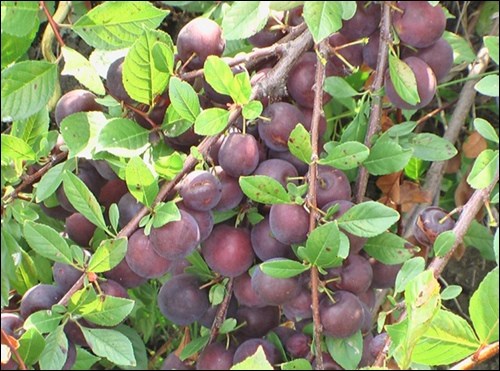Cherry plums are hybrids of our native western sandcherry (Prunus pumila var. besseyi) and the Japanese plum (Prunus salicina). The western sandcherry, generally only a few feet in height, has small white flowers followed by small round astringent fruit, about 1.5-2 centimetre in diameter that are usually black, but sometimes red or yellow.
The Japanese plum, generally with larger, sweeter red or yellow fruit, reaches 7.5 metres in height. Cultivated since ancient times, it spread from China to Japan and other Asian countries. It was introduced to North America in 1870.
In hybridizing these two species, the goal was to produce offspring with the fruit quality of the Japanese plum and the hardiness of the western sandcherry. The result was a bush form of plum with fruit good for processing that tasted much better than sandcherry but unfortunately not as good as the Japanese plum. These crosses, one of the first efforts to develop a hardy plum for northern regions, still have a place in home gardens because of their relatively small plant size. Although the fruit is also small, it is always produced abundantly and is excellent for processing: juice, jelly, jam and syrup. Most are also good for fresh eating when allowed to stay on the bush about a week after ripening, until the first sign of shriveling.
Cherry plums were first introduced in the late 1800s and early 1900s by plant breeders in South Dakota, Alberta, Saskatchewan and Manitoba. They were first called cherry x plums, then cherry plums and more recently in the United States, “chums.” Incidentally, neither sandcherries nor cherry plums are cherries. They are plums the size of cherries.
The fragrant white cherry plum flowers bloom late enough to avoid spring frosts. Fruit size ranges from two to 3.5 centimetres. The skin is green when immature, becoming red to black when ripe. Flesh colour varies from yellow-green to dark red to almost black. Most are semi-clingstone, a few clingstone. They ripen from late August to early September. All cultivars are acceptable pollinizers for each other. Most are propagated by cuttings and are therefore on their own roots.
University of Saskatchewan favourites in terms of flavour, hardiness and purple flesh (which makes a far better jam) are Dura, Manor and New Oka. Other cultivars are Convoy, Green Elf, Opata, Sapa and Sapalta.
Plant one- or two-year old plants in spring, one to 1.2 metres apart in weed-free, well-drained soil in full sun with wind protection. Set them slightly deeper (two to five centimetres) than when in the pot. Firm the soil around the roots and water generously. Ideally, the soil should be a deep, fertile loam with high organic matter content. Avoid low-lying areas that are “frost pockets” or sites with standing water. Mulch generously with weed-free straw or post peelings to conserve moisture and control weeds.
Most soils in the brown and black soil zones have adequate nutrients. It is better to under fertilize than over fertilize. Especially avoid excessive nitrogen that promotes lush foliage, delays the formation of flower buds and may also delay hardening off in fall, leading to winter damage.
These plants are generally shrub-like and bushy, varying in height from 1.5 to three metres. Usually no pruning is needed until the plants are four or five years old at which time they should be thinned. Declining older branches should be removed to encourage more productive younger ones.
Sara is the author of numerous gardening books, among them the revised Creating the Prairie Xeriscape. And with Hugh Skinner: Gardening Naturally; Trees and Shrubs for the Prairies, and Groundcovers & Vines for the Prairies. Expect Fruit for Northern Gardens with Bob Bors in November, 2017.
— This column is provided courtesy of the Saskatchewan Perennial Society (www.saskperennial.ca; hortscene@yahoo.com; www.facebook.com/saskperennial). Check out our Bulletin Board or Calendar for upcoming garden information sessions, workshops, tours and other events: January 25, 7:30 - Keeping your Trees & Shrubs Healthy and Vigorous; Emmanuel Anglican Church.



